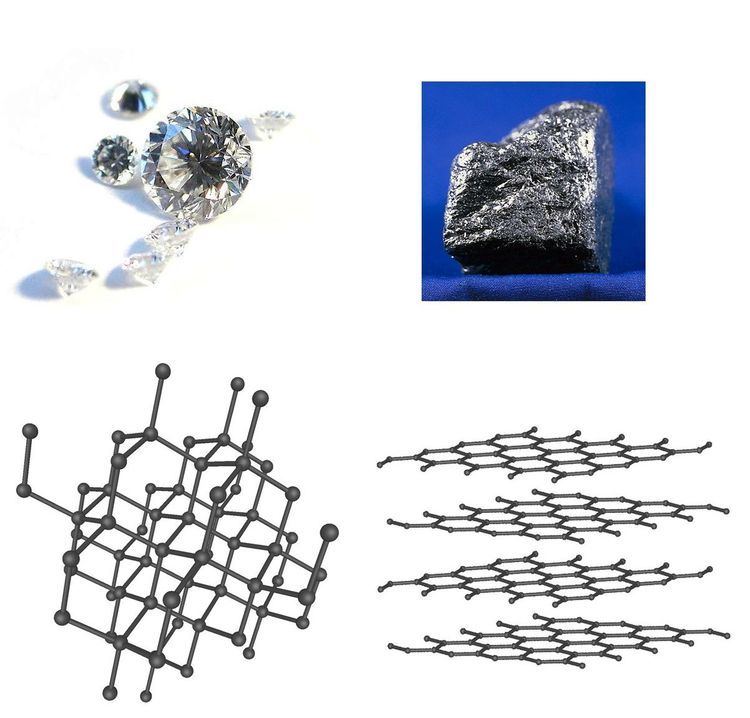 | ||
Allotropy or allotropism (from Greek ἄλλος (allos), meaning "other", and τρόπος (tropos), meaning "manner, form") is the property of some chemical elements to exist in two or more different forms, in the same physical state, known as allotropes of these elements. Allotropes are different structural modifications of an element; the atoms of the element are bonded together in a different manner. For example, the allotropes of carbon include diamond (where the carbon atoms are bonded together in a tetrahedral lattice arrangement), graphite (where the carbon atoms are bonded together in sheets of a hexagonal lattice), graphene (single sheets of graphite), and fullerenes (where the carbon atoms are bonded together in spherical, tubular, or ellipsoidal formations). The term allotropy is used for elements only, not for compounds. The more general term, used for any crystalline material, is polymorphism. Allotropy refers only to different forms of an element within the same phase (i.e. different solid, liquid or gas forms); these different states are not, themselves, considered to be examples of allotropy.
Contents
- History
- Differences in properties of an elements allotropes
- List of allotropes
- Metals
- Lanthanides and actinides
- References
For some elements, allotropes have different molecular formulae which can persist in different phases – for example, two allotropes of oxygen (dioxygen, O2, and ozone, O3), can both exist in the solid, liquid and gaseous states. Conversely, some elements do not maintain distinct allotropes in different phases – for example phosphorus has numerous solid allotropes, which all revert to the same P4 form when melted to the liquid state.
History
The concepts of allotropy was originally proposed in 1841 by the Swedish scientist Baron Jöns Jakob Berzelius (1779–1848). The term is derived from Greek άλλοτροπἱα (allotropia), meaning "variability, changeableness". After the acceptance of Avogadro's hypothesis in 1860 it was understood that elements could exist as polyatomic molecules, and the two allotropes of oxygen were recognized as O2 and O3. In the early 20th century it was recognized that other cases such as carbon were due to differences in crystal structure.
By 1912, Ostwald noted that the allotropy of elements is just a special case of the phenomenon of polymorphism known for compounds, and proposed that the terms allotrope and allotropy be abandoned and replaced by polymorph and polymorphism. Although many other chemists have repeated this advice, IUPAC and most chemistry texts still favour the usage of allotrope and allotropy for elements only.
Differences in properties of an element's allotropes
Allotropes are different structural forms of the same element and can exhibit quite different physical properties and chemical behaviours. The change between allotropic forms is triggered by the same forces that affect other structures, i.e. pressure, light, and temperature. Therefore, the stability of the particular allotropes depends on particular conditions. For instance, iron changes from a body-centered cubic structure (ferrite) to a face-centered cubic structure (austenite) above 906 °C, and tin undergoes a modification known as tin pest from a metallic form to a semiconductor form below 13.2 °C (55.8 °F). As an example of allotropes having different chemical behaviour, ozone (O3) is a much stronger oxidizing agent than dioxygen (O2).
List of allotropes
Typically, elements capable of variable coordination number and/or oxidation states tend to exhibit greater numbers of allotropic forms. Another contributing factor is the ability of an element to catenate.
Examples of allotropes include:
Metals
Among the metallic elements that occur in nature in significant quantities (56 up to U, without Tc and Pm), almost half (27) are allotropic at ambient pressure: Li, Be, Na, Ca, Ti, Mn, Fe, Co, Sr, Y, Zr, Sn, La, Ce, Pr, Nd, Sm, Gd, Tb, Dy, Yb, Hf, Tl, Th, Pa and U. Some phase transitions between allotropic forms of technologically relevant metals are those of Ti at 882 °C, Fe at 912 °C and 1394 °C, Co at 422 °C, Zr at 863 °C, Sn at 13 °C and U at 668 °C and 776 °C.
